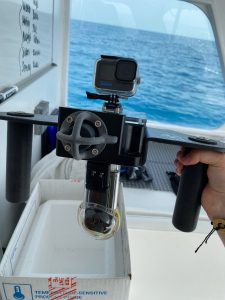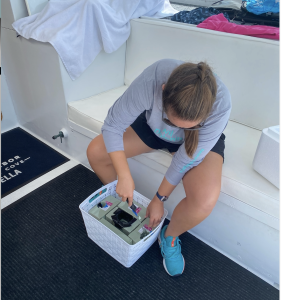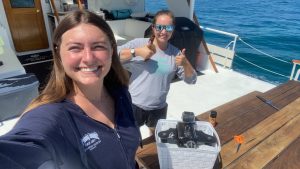Introducing our newest DIY project: the Eagle Nest!
This season, we were thrilled to start using a new camera model—Eagle—which has all of the essential components of our last camera: a GoPro video camera and our TASCAM audio recording device. Eagle is extra special though because it has a 360-degree video camera mounted on the bottom! We always wondered what the dolphins were doing behind our backs and now we’ll finally know! The addition of this 360-degree capability will elevate our data collection, allowing us to capture our dolphin encounters from all angles, ensuring that we don’t miss a thing!

In the past, our cameras could sit securely on the small shelf under the whiteboard on the back deck, tucked under a towel, ready for action when the dolphins appeared. However, with the 360 camera mount on the bottom of Eagle, it quickly became clear that placing it on the shelf in the same way would risk putting strain on the 360 mount. The design required more care, and we needed a solution that would protect the new setup without hindering our ability to grab the camera at a moment’s notice. We had to get crafty—fieldwork style!
At first, we went with a classic quick fix: a cardboard box. While this worked temporarily, the box was too narrow to support Eagle’s “wings” (aka handles) which made the setup unstable, especially in rougher seas. Additionally, after a few days outside, the box got damp (who could have guessed) and it became clear we needed a more durable solution! We went back to the drawing board, and that’s when we developed the idea for a basket-based setup. We found a sturdy basket with a wide base, providing stability in choppy waters. The basket was also spacious enough to accommodate Eagle’s “wings”. To ensure the 360 mount was properly supported, we added foam blocks to the bottom of the basket, which we carefully carved to fit the mount and handles securely. This allowed the camera to sit safely in the basket without any pressure on the mount. We also left space for the protective sleeve that covers the 360 camera when it’s not in use, preventing scratches to the underwater housing. To further protect the equipment from the elements, we lined the inside of the basket with a plastic tablecloth, providing some water resistance and making it easy to clean! The basket itself also has handles making it easy to move the entire setup around the deck—a practical improvement in a fast-paced research environment.

The “Eagle Nest” has proven to be an effective solution to an unforeseen challenge. While it may not be a permanent fix, it’s doing exactly what we need—keeping our equipment safe and ready for action. This experience proves the importance of being resourceful in the field! Sometimes channeling your inner “MacGyver” and improvising with what you’ve got is essential to keeping the research moving forward. It’s all part of the adventure on board Stenella, and we wouldn’t have it any other way!

Allison & Hayley
